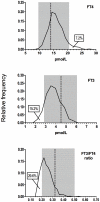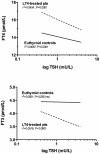Levothyroxine monotherapy cannot guarantee euthyroidism in all athyreotic patients
- PMID: 21829633
- PMCID: PMC3148220
- DOI: 10.1371/journal.pone.0022552
Levothyroxine monotherapy cannot guarantee euthyroidism in all athyreotic patients
Abstract
Context: Levothyroxine monotherapy is the treatment of choice for hypothyroid patients because peripheral T4 to T3 conversion is believed to account for the overall tissue requirement for thyroid hormones. However, there are indirect evidences that this may not be the case in all patients.
Objective: To evaluate in a large series of athyreotic patients whether levothyroxine monotherapy can normalize serum thyroid hormones and thyroid-pituitary feedback.
Design: Retrospective study.
Setting: Academic hospital.
Patients: 1,811 athyreotic patients with normal TSH levels under levothyroxine monotherapy and 3,875 euthyroid controls.
Measurements: TSH, FT4 and FT3 concentrations by immunoassays.
Results: FT4 levels were significantly higher and FT3 levels were significantly lower (p<0.001 in both cases) in levothyroxine-treated athyreotic patients than in matched euthyroid controls. Among the levothyroxine-treated patients 15.2% had lower serum FT3 and 7.2% had higher serum FT4 compared to euthyroid controls. A wide range of FT3/FT4 ratios indicated a major heterogeneity in the peripheral T3 production capacity in different individuals. The correlation between thyroid hormones and serum TSH levels indicated an abnormal feedback mechanism in levothyroxine-treated patients.
Conclusions: Athyreotic patients have a highly heterogeneous T3 production capacity from orally administered levothyroxine. More than 20% of these patients, despite normal TSH levels, do not maintain FT3 or FT4 values in the reference range, reflecting the inadequacy of peripheral deiodination to compensate for the absent T3 secretion. The long-term effects of chronic tissue exposure to abnormal T3/T4 ratio are unknown but a sensitive marker of target organ response to thyroid hormones (serum TSH) suggests that this condition causes an abnormal pituitary response. A more physiological treatment than levothyroxine monotherapy may be required in some hypothyroid patients.
Conflict of interest statement
Figures



Similar articles
-
Serum Thyroid Hormone Balance in Levothyroxine Monotherapy-Treated Patients with Atrophic Thyroid After Radioiodine Treatment for Graves' Disease.Thyroid. 2019 Oct;29(10):1364-1370. doi: 10.1089/thy.2019.0135. Epub 2019 Sep 13. Thyroid. 2019. PMID: 31411123 Free PMC article.
-
Decreased sensitivity of thyrotropin-thyroid hormone feedback control in hypothyroid and athyreotic patients treated with levothyroxine. Is serum triiodothyronine involved?Ann Endocrinol (Paris). 2018 Apr;79(2):62-66. doi: 10.1016/j.ando.2017.11.003. Epub 2018 Mar 9. Ann Endocrinol (Paris). 2018. PMID: 29530271
-
Levothyroxine Therapy Achieves Physiological FT3/FT4 Ratios at Higher than Normal TSH Levels: A Novel Justification for T3 Supplementation?Horm Metab Res. 2018 Nov;50(11):827-831. doi: 10.1055/a-0751-0498. Epub 2018 Nov 5. Horm Metab Res. 2018. PMID: 30396211
-
THERAPY OF ENDOCRINE DISEASE: T4 + T3 combination therapy: is there a true effect?Eur J Endocrinol. 2017 Dec;177(6):R287-R296. doi: 10.1530/EJE-17-0645. Epub 2017 Aug 30. Eur J Endocrinol. 2017. PMID: 28855267 Review.
-
Thyroid function tests: Thyroid disease: assessment and management: Evidence review C.London: National Institute for Health and Care Excellence (NICE); 2019 Nov. London: National Institute for Health and Care Excellence (NICE); 2019 Nov. PMID: 35129920 Free Books & Documents. Review.
Cited by
-
Prevalent polymorphism in thyroid hormone-activating enzyme leaves a genetic fingerprint that underlies associated clinical syndromes.J Clin Endocrinol Metab. 2015 Mar;100(3):920-33. doi: 10.1210/jc.2014-4092. Epub 2015 Jan 8. J Clin Endocrinol Metab. 2015. PMID: 25569702 Free PMC article.
-
Subcutaneous transplantation of human thyroid tissue into a pre-vascularized Cell Pouch™ device in a Mus musculus model: Evidence of viability and function for thyroid transplantation.PLoS One. 2022 Jan 20;17(1):e0262345. doi: 10.1371/journal.pone.0262345. eCollection 2022. PLoS One. 2022. PMID: 35051203 Free PMC article.
-
Effect of Combined Levothyroxine (L-T4) and 3-Iodothyronamine (T1AM) Supplementation on Memory and Adult Hippocampal Neurogenesis in a Mouse Model of Hypothyroidism.Int J Mol Sci. 2023 Sep 8;24(18):13845. doi: 10.3390/ijms241813845. Int J Mol Sci. 2023. PMID: 37762153 Free PMC article.
-
Thyroid and Cardiovascular Disease: Research Agenda for Enhancing Knowledge, Prevention, and Treatment.Thyroid. 2019 Jun;29(6):760-777. doi: 10.1089/thy.2018.0416. Epub 2019 May 13. Thyroid. 2019. PMID: 31081722 Free PMC article.
-
Hypothyroidism and its rapid correction alter cardiac remodeling.PLoS One. 2014 Oct 15;9(10):e109753. doi: 10.1371/journal.pone.0109753. eCollection 2014. PLoS One. 2014. PMID: 25333636 Free PMC article.
References
-
- Bunevicius R, Kazanavicius G, Zalinkevicius R, Prange AJ., Jr Effects of thyroxine as compared with thyroxine plus triiodothyronine in patients with hypothyroidism. N Engl J Med. 1999;340:424–9. - PubMed
-
- Appelhof BC, Fliers E, Wekking EM, Schene AH, Huyser J, et al. Combined therapy with levothyroxine and liothyronine in two ratios, compared with levothyroxine monotherapy in primary hypothyroidism: a double-blind, randomized, controlled clinical trial. J Clin Endocrinol Metab. 2005;90:2666–74. - PubMed
-
- Woeber KA. Levothyroxine therapy and serum free thyroxine and free triiodothyronine concentrations. J Endocrinol Invest. 2002;25:106–9. - PubMed
-
- Iverson JF, Mariash CN. Optimal free thyroxine levels for thyroid hormone replacement in hypothyroidism. Endocr Pract. 2008;14:550–5. - PubMed
Publication types
MeSH terms
Substances
LinkOut - more resources
Full Text Sources
Other Literature Sources
Medical

